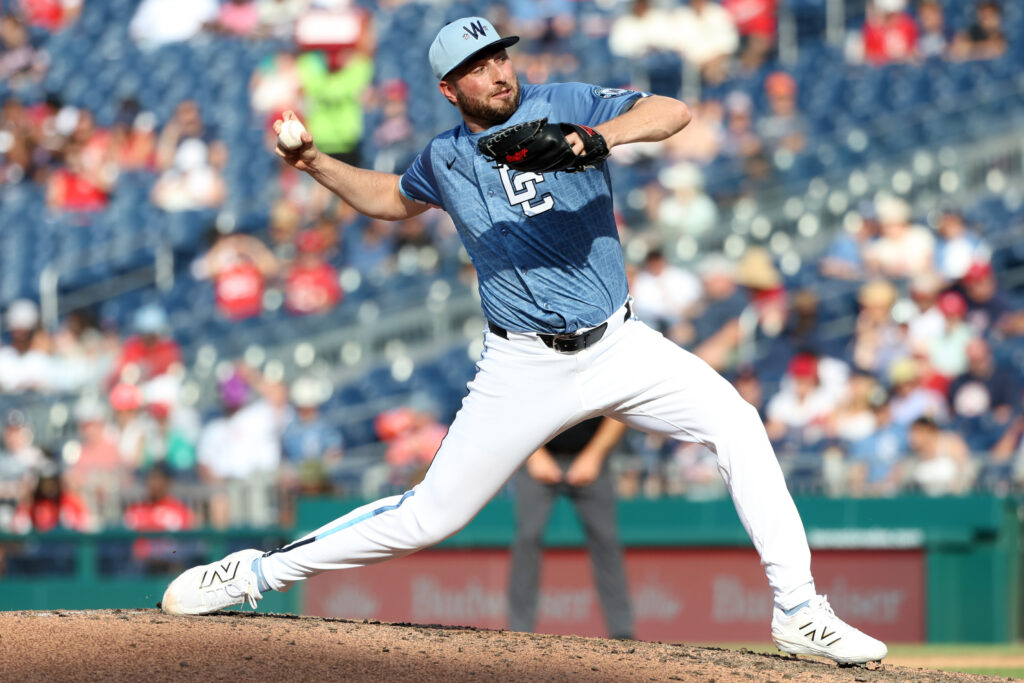For the second consecutive day, the Seattle Mariners have strengthened their bullpen depth by adding another arm to their 40-man roster. On Thursday, the team announced that they had claimed right-handed pitcher Ryan Loutos off waivers from the Washington Nationals. The move followed another bullpen-related addition just one day earlier when Seattle acquired right-hander Cole Wilcox from the Tampa Bay Rays in exchange for cash considerations. These back-to-back transactions reflect the Mariners’ continued focus on fortifying their pitching staff as the offseason begins to take shape.
Ryan Loutos, who now joins Seattle’s organization, brings an intriguing combination of physicality, intelligence, and versatility both on and off the field. Standing at six feet five inches tall and weighing around 240 pounds, Loutos is a physically imposing presence on the mound. The Illinois native, who hails from Elk Grove Village, has a strong connection to the Pacific Northwest as well. He attended Washington University in St. Louis, a Division III school known more for academics than baseball prowess, yet one that played a pivotal role in his development both as a pitcher and as a person. Adding a touch of coincidence to his story, he also attended Barrington High School in Illinois, the same high school that produced Mariners manager Dan Wilson, a fun bit of trivia that connects the two within the organization.
Loutos’ professional baseball journey is an unconventional and inspiring one. After completing his college career, he went undrafted in 2021, a setback that might have ended the careers of many aspiring players. However, Loutos’ talent and intellect caught the attention of the St. Louis Cardinals, who saw potential not only in his arm but also in his mind. As reported by Derrick Goold of the St. Louis Post-Dispatch, the Cardinals signed Loutos as both a pitching prospect and a valuable contributor to their technological and developmental efforts. They invited him to work with their research and analytics department, where he helped develop a mobile app designed to allow minor league pitchers within the organization to easily access their pitching data and performance metrics. This unusual dual role highlighted his background in computer science and his ability to bridge the gap between technology and player development.

In a 2024 interview with MLB.com’s John Denton, Loutos reflected on that period of his career, discussing how his teammates often turned to him for help with data and technology. “I’ve definitely been that tech guy for most of my minor league teammates,” Loutos said. “They would come to me first because I was their friend, and they felt comfortable asking me questions. I helped out with some of the pitching app development, but the people in the front office were incredibly smart and skilled at what they did. I learned a tremendous amount from them.” His comments underscored his humility and his enthusiasm for learning, two qualities that have served him well as he’s worked to carve out a major league career.
After steadily progressing through the Cardinals’ farm system, Loutos finally achieved his lifelong dream when he made his Major League Baseball debut in 2024. He made three relief appearances for St. Louis that season, pitching three scoreless innings in total and showing flashes of promise with his composure and command. Though his time with the Cardinals’ big league club was brief, it was enough to demonstrate that he belonged at the highest level of competition.
Loutos’ next opportunity came quickly. In May of 2024, he was purchased by the Los Angeles Dodgers, a team known for its deep pitching development system and data-driven approach an environment that seemed well-suited for a player of his analytical mindset. He made two appearances for the Dodgers during their championship season, contributing as a bullpen depth piece for a team that went on to win the World Series. Although he was not a central figure in their postseason run, the experience of being part of a championship-caliber organization added another valuable chapter to his professional story.
“I’ve definitely been that (tech) guy for all of my minor league teammates for the most part,” Loutos said. “The players will come to me first because I’m their friend and they’re comfortable around me. I helped with some of the pitching app, but all the people in the front office are so smart and so good at what they do. I learned so much from them.”

His tenure with the Dodgers ended in June when he was claimed off waivers by the Washington Nationals. The move gave Loutos another chance to prove himself, this time on a rebuilding team that could afford to give younger pitchers extended looks in live game situations. During the 2025 season, he appeared in twelve games for the Nationals, logging twelve innings of work. However, the results were inconsistent. Loutos allowed seventeen earned runs on twenty hits, including four home runs, while walking eight batters and striking out eight. The rough stretch resulted in an earned run average of 12.75 and a walks plus hits per inning pitched (WHIP) of 2.33. Despite those numbers, there remained interest in his potential, particularly because of his pitch mix and the quality of his raw stuff, which metrics suggest could still develop into something more reliable.
Statcast data paints a clearer picture of what Loutos brings to the mound. His fastball is a four-seam variety that averages 95.4 miles per hour, giving him above-average velocity for a reliever. He complements that with an array of secondary pitches, including a slider, changeup, sweeper, and sinker. In his 2025 outings, he relied most heavily on the fastball, using it 46.3 percent of the time, followed by his slider, which accounted for 22.5 percent of his pitches. The variety in his arsenal demonstrates his willingness to experiment and adapt, and his pitch characteristics — particularly the velocity and movement profile of his slider give pitching coaches a foundation to build upon. Given Seattle’s reputation for developing pitchers and maximizing their strengths, the organization could see an opportunity to help Loutos refine his command and improve his consistency.

The Mariners’ front office, led by general manager Justin Hollander, has been active early in the offseason, seeking undervalued talent and depth pieces who could provide flexibility on the pitching staff. Adding Loutos fits that mold. Seattle has often targeted pitchers with analytical backgrounds or those who can benefit from their player development infrastructure. The team’s track record of identifying and improving pitchers from bullpen arms like Paul Sewald and Justin Topa to starters like Logan Gilbert and George Kirby shows that they are confident in their ability to turn potential into production. Loutos, with his analytical mindset and adaptable nature, seems like a natural fit for that environment.
Seattle’s bullpen has been one of its strengths in recent seasons, but the front office knows how crucial depth is over a 162-game schedule. Injuries, fatigue, and performance fluctuations can quickly test even the best relief units. By adding arms like Loutos and Wilcox, the Mariners are ensuring that they have a broad pool of options to draw from throughout the season. Both pitchers could start the year at Triple-A Tacoma, where they would provide immediate reinforcements should the big-league bullpen need support.
Loutos’ path to Seattle also highlights the unpredictable nature of baseball careers. From going undrafted to developing data apps for the Cardinals, to pitching for multiple organizations in a short time, his story is one of perseverance and adaptability. Each stop has given him valuable experience, and the Mariners are clearly betting that his combination of intelligence and raw ability can still blossom into consistent major league performance.
From a roster management perspective, Loutos’ addition leaves the Mariners’ 40-man roster at 38 players, giving the team some flexibility to make further moves as the offseason progresses. That flexibility could prove useful as the front office continues to evaluate free-agent and trade options to address both bullpen and lineup needs. With the team expected to pursue additional offensive reinforcements and possibly another starting pitcher, having open roster spots ensures they can make additions without being forced into corresponding subtractions immediately.
As Loutos joins his new organization, the Mariners will likely spend the coming months evaluating him closely during spring training and early-season assignments. His ability to command the strike zone and limit hard contact will be key areas of focus. If he can make adjustments to his delivery or refine his pitch sequencing — areas where Seattle’s pitching coaches have excelled with other players he could carve out a role as a middle-relief or multi-inning option out of the bullpen.
For now, the move reflects Seattle’s broader strategy of leaving no stone unturned in the search for pitching depth. Loutos may not be a household name, but his story embodies the kind of under-the-radar acquisition that can sometimes pay significant dividends over the course of a long season. With his size, fastball velocity, and analytical understanding of pitching mechanics, he represents an intriguing project for a Mariners organization known for its ability to get the most out of pitchers with untapped potential.
Ultimately, whether Ryan Loutos becomes a key contributor for the Mariners or serves as a depth piece, his addition is another step in Seattle’s ongoing efforts to construct a roster capable of competing deep into the season. His combination of intelligence, perseverance, and raw ability gives him a chance to make an impression, and for a team that prides itself on development and innovation, that is exactly the type of player worth taking a chance on. With the addition of Loutos, the Mariners’ 40-man roster now stands at 38 players, leaving room for further moves as the offseason continues.







